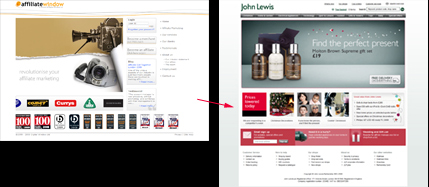A Beginner Affiliate's Guide to Affiliate Marketing
, 14th April 2009
, 14th April 2009
We often get asked to explain what Affiliate Marketing is - and whilst there's far too much too it for one blog post, I can at least give an over view here.
If you're considering entering into the Affiliate Marketing world though, give us a shout as we provide consultancy on the subject and can warn you of any pitfalls your particular service/product/site is likely to encounter.
Overview
Affiliate Marketing is the process of earning a commission on sales you generate for a Merchant.
Glossary
Affiliate / Publisher – you.
Merchant – the retailer you are earning commission from.
Affiliate Network – a middle man who can put you and the Merchant in touch and manage the process.
Affiliate URL – the link you use to send a visitor to a Merchants website. This link contains code which ties that visitor to you, so the Merchant knows to pay you a commission.
Commission Tiers – if you make lots of sales for a Merchant, as a thank you (and to encourage you further) they may put you on a higher tier of commission. They may pay you for example, 15%, when they usually only pay 12%.
Creative – the term used for banners/pictures/artwork you use on your site to promote a Merchant.
Deep Linking – this refers to linking to a particular page of a Merchants website, perhaps to send a visitor directly to a particular product, rather than to just the home page.
Conversion Rate – this represents the percentage of visitors to a Merchants site that actually go on to buy something. If a Merchant has a particularly low conversion rate, this may be because their website is difficult to navigate or faulty, so people do not end up placing an order. Therefore you may decide to invest your efforts into promoting a different Merchant with a higher conversion rate, who provides a better customer experience.
Cookie – some information is picked up from the visitors computer when they click on your affiliate URL, and passed from your site to the Merchants site so that they can track that the visitor came from you. Cookies have been given a bad press – but they are not all created to threaten/attack people’s privacy! Your website will not use Cookies, but you should state somewhere that sites you link to use Cookies.
There can be 2 or 3 parties involved in Affiliate Marketing.
In-house Affiliate Programmes.
This involves you getting some code directly from a Merchant and placing it on your website. You will have a log in to the Merchants website from which you can get links, creative, and check your balance/commissions.
You will then send people who visit your site, to the Merchants site, via your special affiliate link. When you do so, a ‘cookie’ is set on the Merchants site, telling it that that computer/visitor came from you. When/if that visitor places an order, code on the Merchants site will use that cookie t determine that you need to be paid a commission.
Example: The beauty website LoveLula.com has an In-house affiliate programme.

I. You create an account with LoveLula.com, and get your affiliate URL.
II. You then send people to the LoveLula.com website via this link.
III. LoveLula.com matches that visitor to you and pays you a commission on anything that visitors buys.
IV. You log in to your LoveLula.com account (on their website) to check your balance.
Going via an Affiliate Network.
A Network stores all the programme details (creative, links, commission structures) for hundreds of Merchants.
From your point of view, it means it is easy to find lots of Merchants to link to, all in one place. Also, to check your balance/commissions earned, you need only go to one place (or just a couple if you are a member of more than one Network). If a commission doesn’t track (you know someone went through your site and bought something but you didn’t get your percentage) you can talk to the Network who will try to fix the problem (and hopefully compensate you).
Example: John Lewis uses the Network Affiliate Window (please note: some Merchants use more than one Network – John Lewis are also with Tradedoubler).

I. You create an account with Affiliate Window, and get your affiliate URL.
II. You then send people to the John Lewis website via this link, (which, without your visitors knowing, goes via Affiliate Window).
III. Code on the John Lewis website then matches that visitor to you and pays you a commission on anything that visitors buys and reports back to the Affiliate Window system.
IV. You log in to your Affiliate Window account (on their website) to check your balance.
Examples of some Affiliate Networks are: Affiliate Window, Tradedoubler, Affiliate Future, and Webgains.
29.02.24
We are delighted to announce that 18a has been recognised for its outstanding work in the "Web Design Agency of the Year - UK" category at… Read →
27.02.24
I recently had an interesting problem to solve. I'd built a brand new author website on a shiny installation of Laravel 10, utilising its out-of-the-box… Read →
15.02.24
WordPress is the incredibly popular blogging-come-full-website platform that powers over 835 million websites* in 2024. It's functionality is extended by plugins, and one such very… Read →